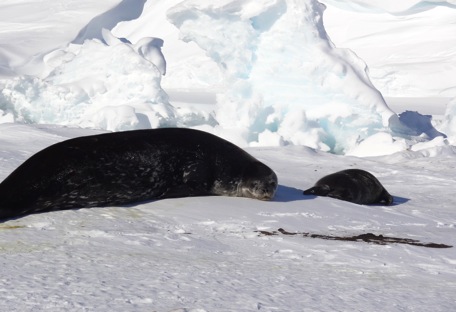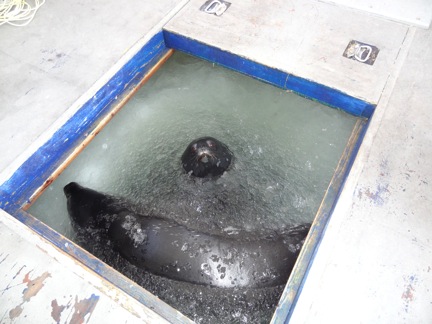More Weddell seal tag recoveries
Our research team has made a lot of progress this past week - We’ve been very, very busy!
In the last journal we mentioned that our collaborators had found dive recorders from WS12-12 (“Boo”) and WS12-13 (“Lucky”). This week we were able to relocate these two animals and complete the physiology assessment. Both days we were working were gorgeous and warm! The team even took Big Red off awhile.
This week the team also had their first encounter of the year with some emperor penguins.

Boo had a pup with her, who was approximately 2 weeks old. Last year Boo weighed 374 kg, and this year she weighed 355 kg.
If you noticed from the last journal entry, when we find seals who have given birth about 5 days before, they usually weigh a lot more. However, as the seals nurse their pups, they give the pups a lot of high-fat milk. So the pups gain mass very quickly, and the mom loses mass very quickly. Female Weddell seals can lose approximately 30% of their body mass while nursing their pups.
Lucky did not have a pup this year. She weighed almost the exact same this year as she did last year (410 kg last year vs. 408 kg this year). She seemed very healthy and had lipemic blood samples (blood with some lipid- makes serum appear cloudy), which suggests that she is still foraging often. Probably since she doesn’t have to remain on the ice all day and night like some of our other Weddell seals that have to tend to their pups.
Boo and Lucky are very valuable animals for our study- with the behavior and the physiology for both seals!
We also found animal WS12-17 (“Scout”). Unfortunately she has lost her tag. But she has a pup and we were also able to get our health assessment done. Like Lucky, she also maintained her weight across the year (347 kg last year and 339 kg this year). Scout had a very active pup! The pup kept running around everywhere while we were working, and kept mom very busy keeping up with her after we finished our health assessment.

WS12-04 (“Stretch”) was seen by another seal research team, and after 3 days of searching, we finally found her! She did not have a pup; so she was likely moving around the area quite a bit. She still had her tag too! So that was very exciting for the group. Stretch had a successful year foraging, as she gained some weight this year (she weighed 440 kg last year and 475 kg this year- so she gained 77 pounds).

The team flew by helicopter further north and was able to find WS12-02 (“Patches”) and WS12-07 (“Fluffy”). These seals both lost their tags, but they have pups. We were able to do a health assessment for Patches. She weighed 351 kg last year and 368 kg this year.
Finally, the team went to a nearby fish hut to drop a conductivity time depth (CTDA research tool that is submerged in the water to measure conductivity (salinity), temperature, and depth.) instrument into the fishing hole. This collects some oceanographic data in the area to determine how much temperature and salinity within the water column changes between seasons. This is also used to support the accuracy of the oceanographic data we receive from our seals’ dive recorders. As soon as we started lowering the instrument into the water, 4 curious Weddell seals appeared in the fishing hole to see what we were doing.

One of these curious seal had our tag! This was WS12-19 (Glory) who allowed us to take pictures, before swimming off.

The seals can’t get out of the fishing hole into the fish hut, so the team is now looking for her at other cracks and holes in the area. Hopefully, we can catch her while she is hauled-out on the ice so we can get her tag back and perform the physiology assessment. Her tag hasn’t transmitted data via satellite since April, but it is possible that the tag has been storing all the behavior and oceanographic data for the 6-7 months since it stopped transmitting data. This would be a very valuable tag for us to get back!
The team hasn’t even been in McMurdo for 2 weeks and we have already gotten 5 tags back and performed 7 health assessments! And there is another potential tag near the station. We are all incredibly happy with this season’s progress!
- < prev
- 103 of 103


Comments